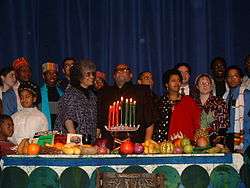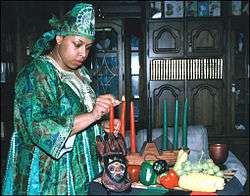Kwanzaa
| Kwanzaa | |
|---|---|
 2003 Kwanzaa celebration with Maulana Karenga, its founder, and others | |
| Observed by | African Americans, parts of African diaspora |
| Type | Cultural and ethnic |
| Significance | Celebrates African heritage, unity, and culture. |
| Celebrations |
Unity Creativity Faith Giving gifts |
| Date | December 26 to January 1 |
| Related to | Pan-Africanism |
Kwanzaa (/ˈkwɑːn.zə/) is a week-long celebration held in the United States and in other nations of the Western African diaspora in the Americas. The celebration honors African heritage in African-American culture, and is observed from December 26 to January 1, culminating in a feast and gift-giving.[1] Kwanzaa has seven core principles (Nguzo Saba). It was created by Maulana Karenga and was first celebrated in 1966–67.
History and etymology
Maulana Karenga created Kwanzaa in 1966, as the first specifically African-American holiday,[2] (but see also Juneteenth). According to Karenga, the name Kwanzaa derives from the Swahili phrase matunda ya kwanza, meaning "first fruits of the harvest",[3] although a more conventional translation would simply be "first fruits". The choice of Swahili, an East African language, reflects its status as a symbol of Pan-Africanism, especially in the 1960s, although most of the Atlantic slave trade that brought African people to America originated in West Africa.[4]
Kwanzaa is a celebration that has its roots in the black nationalist movement of the 1960s and was established as a means to help African Americans reconnect with their African cultural and historical heritage by uniting in meditation and study of African traditions and Nguzo Saba, the "seven principles of African Heritage" which Karenga said "is a communitarian African philosophy". For Karenga, a major figure in the Black Power movement of the 1960s and 1970s, the creation of such holidays also underscored an essential premise that "you must have a cultural revolution before the violent revolution. The cultural revolution gives identity, purpose and direction."[5]
During the early years of Kwanzaa, Karenga said that it was meant to be an alternative to Christmas, that Jesus was psychotic, and that Christianity was a white religion that black people should shun. [6] However, as Kwanzaa gained mainstream adherents, Karenga altered his position so that practicing Christians would not be alienated, then stating in the 1997, Kwanzaa: A Celebration of Family, Community, and Culture, "Kwanzaa was not created to give people an alternative to their own religion or religious holiday."[7] Many African Americans who celebrate Kwanzaa do so in addition to observing Christmas.[8]
Principles and symbols

Kwanzaa celebrates what its founder called the seven principles of Kwanzaa, or Nguzo Saba (originally Nguzu Saba—the seven principles of African Heritage), which Karenga said "is a communitarian African philosophy," consisting of what Karenga called "the best of African thought and practice in constant exchange with the world." These seven principles comprise Kawaida, a Swahili word meaning "common". Each of the seven days of Kwanzaa is dedicated to one of the following principles, as follows:[9]
- Umoja (Unity): To strive for and to maintain unity in the family, community, nation, and race.
- Kujichagulia (Self-Determination): To define and name ourselves, as well as to create and speak for ourselves.
- Ujima (Collective Work and Responsibility): To build and maintain our community together and make our brothers' and sisters' problems our problems and to solve them together.
- Ujamaa (Cooperative Economics): To build and maintain our own stores, shops, and other businesses and to profit from them together.
- Nia (Purpose): To make our collective vocation the building and developing of our community in order to restore our people to their traditional greatness.
- Kuumba (Creativity): To do always as much as we can, in the way we can, in order to leave our community more beautiful and beneficial than we inherited it.
- Imani (Faith): To believe with all our hearts in our people, our parents, our teachers, our leaders, and the righteousness and victory of our struggle.
Kwanzaa celebratory symbols include a mat (Mkeka) on which other symbols are placed: a Kinara (candle holder), Mishumaa Saba (seven candles), mazao (crops), Muhindi (corn), a Kikombe cha Umoja (unity cup) for commemorating and giving shukrani (thanks) to African Ancestors, and Zawadi (gifts). Supplemental representations include a Nguzo Saba poster, the black, red, and green bendera (flag), and African books and artworks – all to represent values and concepts reflective of African culture and contribution to community building and reinforcement.[10] Corn is the primary symbol for both decoration and celebratory dining.
Observance

Families celebrating Kwanzaa decorate their households with objects of art, colorful African cloth such as kente, especially the wearing of kaftans by women, and fresh fruits that represent African idealism. It is customary to include children in Kwanzaa ceremonies and to give respect and gratitude to ancestors. Libations are shared, generally with a common chalice, Kikombe cha Umoja, passed around to all celebrants. Non-African Americans also celebrate Kwanzaa.[11] The holiday greeting is "Joyous Kwanzaa".[12][13][14]
A Kwanzaa ceremony may include drumming and musical selections, libations, a reading of the African Pledge and the Principles of Blackness, reflection on the Pan-African colors, a discussion of the African principle of the day or a chapter in African history, a candle-lighting ritual, artistic performance, and, finally, a feast (karamu). The greeting for each day of Kwanzaa is Habari Gani?[15] which is Swahili for "How are you?"[16]
At first, observers of Kwanzaa avoided the mixing of the holiday or its symbols, values, and practice with other holidays, as doing so would violate the principle of kujichagulia (self-determination) and thus violate the integrity of the holiday, which is partially intended as a reclamation of important African values. Today, many African American families celebrate Kwanzaa along with Christmas and New Year's.[17] Frequently, both Christmas trees and kinaras, the traditional candle holder symbolic of African American roots, share space in Kwanzaa-celebrating households. For people who celebrate both holidays, Kwanzaa is an opportunity to incorporate elements of their particular ethnic heritage into holiday observances and celebrations of Christmas.
Cultural exhibitions include the Spirit of Kwanzaa, an annual celebration held at the John F. Kennedy Center for the Performing Arts featuring interpretive dance, African dance, song and poetry.[18][19][20]
Popularity
In 2004, BIG Research conducted a marketing survey in the United States for the National Retail Foundation, which found that 1.6% of those surveyed planned to celebrate Kwanzaa. In a 2006 speech, Maulana Karenga asserted that 28 million people celebrate Kwanzaa. He has always claimed it is celebrated all over the world.[1] Lee D. Baker puts the number at 12 million.[21] The African American Cultural Center claimed 30 million in 2009.[22] In 2011, Keith Mayes said that 2 million people participated in Kwanzaa.[22]
According to University of Minnesota Professor Keith Mayes, the author of Kwanzaa: Black Power and the Making of the African-American Holiday Tradition, the popularity within the US has "leveled off" as the black power movement there has declined, and as of 2009 between 500 thousand and two million people celebrated Kwanzaa in the US, or between one and five percent of African Americans. Mayes added that white institutions now celebrate it.[11]
The holiday has also spread to Canada and is celebrated by Black Canadians in a similar fashion as in the United States.[23] According to the Language Portal of Canada, "this fairly new tradition has [also] gained in popularity in France, Great Britain, Jamaica and Brazil".[24]
In Brazil, in recent years the term Kwanzaa has been applied by a few institutions as a synonym for the festivities of the Black Awareness Day, commemorated on November 20 in honor of Zumbi dos Palmares,[25][26] having little to do with the celebration as it was originally conceived.
In 2009, Maya Angelou narrated the documentary The Black Candle, a film about Kwanzaa.
Stjepan Meštrović, a sociology professor at the Texas A&M University, sees Kwanzaa as an example of postmodernism. According to Meštrović, modern society has discarded ancient traditions as racist, sexist or otherwise oppressive, but since living in a world where nothing is true is too terrifying to most people, "nice" and "synthetic" traditions like Kwanzaa have been created to cope with the nihilistic, individualistic modern society.[27]
See also
- Dashiki – a shirt or suit worn during Kwanzaa celebrations
References
- 1 2 "Why Kwanzaa Video". "Maulana Karenga". Retrieved 2016-12-27.
- ↑ Alexander, Ron (1983-12-30). "The Evening Hours". New York Times". Retrieved 2006-12-15.
- ↑ Holly Hartman, Kwanzaa – Honoring the values of ancient African cultures
- ↑ "The Atlantic Slave Trade - Herbert S. Klein - Google Books". Books.google.com. 1999-04-13. Retrieved 2016-12-27.
- ↑ Mayes, Keith A. (2009). Kwanzaa: Black Power and the Making of the African-American Holiday Tradition. pp. 63–65. ISBN 978-0415998550. Retrieved 2015-12-27.
- ↑ Karenga, Maulana (1967). "Religion". In Clyde Halisi, James Mtume. The quotable Karenga. Los Angeles: University of Sankore Press. pp. 25. 23769.8.
- ↑ Karenga, Maulana (1997). Kwanzaa: A Celebration of Family, Community and Culture. University of Sankore Press. p. 121. ISBN 978-0943412214.
- ↑ Williams, Lena (1990-12-20). "In Blacks' Homes, the Christmas and Kwanzaa Spirits Meet". The New York Times. Retrieved 2010-05-07.
- ↑ "The Founder's Message 2000". The Official Kwanzaa Website. Retrieved 2016-12-27.
- ↑ "The Symbols of Kwanzaa". The Official Kwanzaa Website. Retrieved 9 January 2016.
- 1 2 Keith Mayes, cited by Megan K. Scott, "Kwanzaa celebrations continue, but boom is over", Buffalo News, 17 December 2009. Accessed 25 December 2009.
- ↑ Bush, George W. (2004-12-23). "Presidential Kwanzaa Message, 2004". Office of the Press Secretary. Retrieved 2007-12-24.
- ↑ "Clinton offers holiday messages". CNN. 1997-12-23. Retrieved 2007-12-24.
- ↑ Gale, Elaine (1998-12-26). "Appeal of Kwanzaa continues to grow; holidays: today marks start of the seven-day celebration of African culture, which began in Watts 32 years ago and is now observed by millions.". Los Angeles Times. Retrieved 2007-12-24.
- ↑ "The Founder's Message 2000". The Official Kwanzaa Web Site. Retrieved 2016-12-27.
- ↑ "Useful Swahili phrases". Omniglot.com. Retrieved 2016-12-27.
- ↑ "Kwanzaa (until Jan 1) in the United States". Timeanddate.com. Retrieved 2016-12-27.
- ↑ "The Spirit of Kwanzaa - The John F. Kennedy Center for the Performing Arts". Kennedy-center.org. Retrieved 2016-12-27.
- ↑
- ↑
- ↑ Manning Marable, Dispatches from the Ebony Tower, p. 224.
- 1 2 "Kwanzaa celebration unites African-American community", The Post, Ohio University, 1 November 2011. Accessed 31 December 2014.
- ↑ "The principles of Kwanzaa". CBC. Dec 28, 1993. Retrieved 2011-12-16.
- ↑ "Celebrate Kwanzaa!". Government of Canada. 2011-02-21. Retrieved 2011-12-16.
- ↑ "Portal da Prefeitura da Cidade de São Paulo". Prefeitura.sp.gov.br. Retrieved 2016-12-27.
- ↑
- ↑ S. G. Mestrovic (January 2000). "Postemotional Law". Ro.uow.edu.au. Retrieved 2016-12-27.
External links
- Official website
- The Black Candle: a Kwanzaa film narrated by Maya Angelou
- Why Kwanzaa was created by Karenga
- The History Channel: Kwanzaa
- Interview: Karenga discusses the evolution of the holiday and its meaning. Tavis Smiley (NPR)